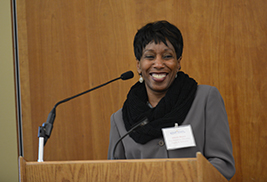Featured Article
Kent State’s Alfreda Brown Elected to National Association of Diversity Officers in Higher Education Board
The National Association of Diversity Officers in Higher Education (NADOHE) has elected Alfreda Brown, Kent State University’s vice president for diversity, equity and inclusion, to serve a three-year term on its board of directors.
read moreKent State Student Introduces New Method of Circadian Research
Posted March 2, 2015 | Ashlyne Wilson
Kent State University chemistry senior Caitlin Crosier
has introduced a new method of circadian research.
Crosier will present her findings at Kent State's
Undergraduate Research Symposium on March 11.
Kent State University chemistry senior Caitlin Crosier combined creativity and science to her yearlong project on circadian rhythms and will present those findings at the university’s Undergraduate Research Symposium on March 11.
“The main goal of my research is to validate this method as a way to look at the circadian rhythm structure of an entire population because most current human circadian research is conducted on very small populations and controlled environments,” Crosier says.
Circadian rhythms are physical, mental and behavioral changes that follow a 24-hour cycle, responding to light and darkness in an organism’s environment, according to the National Institute of General Medical Sciences’ website.
Crosier’s research, titled “Circadian Analysis on Human Population Entrainment: Inferences from the Power Grid,” was published in Chronobiology International last October.
Her analysis examined data from the Pacific Northwest region and how it correlates to the entire population of 43 million people’s circadian rhythms and their daily activities. Crosier’s examination included looking at raw data of electrical usage of the regional area by a database that is updated every five minutes by the company that sells electricity to that region.
“I presented this project last year, but it was incomplete, and I took a lot of my criticism from the judges and improved it,” she says. “I presented it again at the Society of Biological Rhythms in Montana in the summer and published it in October.”
Crosier hopes to attend medical school after graduation and will cite this research on her application as relevant experience.
“The research symposium helped me with professional development and my communication in the field,” Crosier says. “I learned that I can come off very nervous while presenting, and this really helped me get over that.”
The Undergraduate Research Symposium is on March 11 from 1-5 p.m. and is sponsored by the Office of the Provost, Honors College, Division of Research and Sponsored Programs, Undergraduate Studies and University Libraries. The symposium celebrates research and scholarship across all disciplines, and is an opportunity for undergraduate students to gain experience presenting their work in an academic setting and for networking with faculty members.
J. David Glass, a Kent State biological sciences professor who runs his research lab with graduate students and undergraduate trainees, provided guidance for Crosier’s research.
“I provided her with the public website domain that contains the data for the whole project,” Glass says. “What she did was pair our computer programs with that database to analyze that data and put it together in a presentable form.”
Glass says this research was groundbreaking because no one ever thought to do research on circadian rhythms on such a large human population using electrical power grid data.
“It gives us the first insight into the circadian pattern of a very large industrialized human population,” he says. “Human circadian measurements are usually done at the individual level. They’ll take someone in the lab and measure their rhythms or they might do small groups, but no one has ever done that on 43 million people.”
Glass says he is very proud of Crosier because this research is good for her academic development, the lab that she worked in and for her affiliated Honors College program.
For more information about Kent State’s Undergraduate Research Symposium, visit www.kent.edu/ugresearch.
